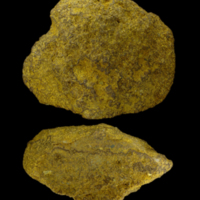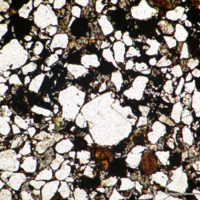- Home
- Rocks
- Type fossils
- Fossil Specimens
- Minerals
- Glossary
- Stratigraphic Chart
- Michel-Levy Chart
- Classification of igneous rocks
- University of Cambridge
- Department of Earth Sciences
- ESC Library
- Moodle
- Sedgwick Museum
- DoITPoMS
- Mindat.org
- Microfossils
- Bryozoans
- Webmineral
- Tree of Life
- CrystalMaker
- Virtual Microscope
L327 - Sandstone, ferruginous
Age
Cretaceous
Location
Carston, Lower Greensand
Hunstanton
Hand Specimen
Mainly medium sand (to coarse sand in the case of L327a).
Yellow-brown iron stained quartz, cemented by the same yellow brown oxide. A few larger quartz grains up to 5 mm long. Grains are angular to sub-rounded, and poorly sorted.
Fizzing with acid, indicating that there is a carbonate cement.
Thin-section
Angular to sub-angular grains of quartz, displaying undulose extinction.
Most have thin brown rims of iron oxide.
A few grains of feldspar.
Minor carbonate cement (sparite).
Rock History
Deposited in an aqueous environment, since it is not clean enough to be aeolian.
Advanced Notes
Iron staining
Hematite (Fe2O3) → red (blood-red, cherry-red, brown-red) iron-staining
Limonite (FeO(OH)•nH2O) → yellow or brown iron-staining
The yellow colour of this rock is probably produced by limonite.
Rock Name
ferruginous sandstone



